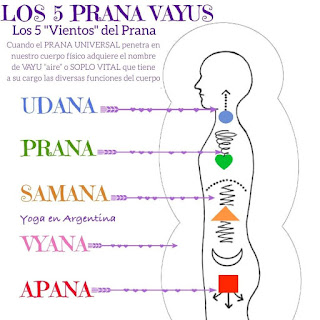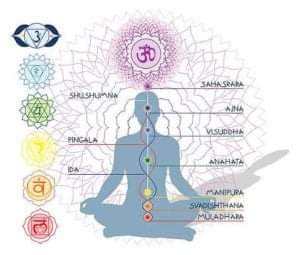Pancha pranas
SHIVA GURU SPARK VASI YOGA 🧘♂️
Kundalini--- Five Vayus
Samana
Physical level: Samana is the third prana. It operates
between the navel and the diaphragm. The word samana is
derived from the root saman, meaning 'equal' or 'balanced'.
Thus it acts as a balancer or equalizer for the two opposite
forces of prana and apana. Samana activates and maintains
the digestive organs and their secretions, and is responsible
for metabolism. It is associated with the digestive fire,
jatharagni. Samana is experienced as a sideways movement
of light, like the swinging of a fast pendulum, from right to
left and left to right. It is responsible for the manipura
experience of vitality and dynamism.
There are six major organs of digestion: liver, stomach,
duodenum, spleen, and the small and large intestines, and all
fall within the field of samana. The body receives its life support
and healthy nourishment by the agency of samana. The
distinctive feature of samana is that although it is a single force,
it is capable of different activities in all these different organs.
Subtle level: Samana maintains the cohesion and balance
between the koshas. It is subtle in comparison to apana and
gross in comparison to prana. Just as it helps digest food,
samana is also responsible for digesting the mind-stuff.
Indications of imbalance: Samana, the equalizer, is disturbed whenever one's mental peace and harmony are
disturbed. Whenever there is turbulence in the body and the
senses, samana becomes agitated and causes disorders. Poor
assimilation of food is a result of samana imbalance, causing
build-up of toxins as well as psychological blockage.
Udana
Physical level: Udana is the fourth manifestation, which
operates in the extremities: the arms, legs, neck and head.
This prana is responsible for all the sensory organs,jnanendriyas, and the organs of action, karmendriyas. It coordinates and
controls the movements of the legs, arms and neck and directs
the activities of the brain and sensory organs that are situated
in the head region. These include: eyes, vision; ears, hearing;
52
tongue, taste; nose, smell; skin, tactile sensation. The organs
of action controlled by udana are three: hands, feet and speech.
The other two, the excretory and reproductive organs, are
under the control of apana.
Udana also assists prana in inhalation and exhalation,
intake of food and drink, as well as vomiting, spitting and
swallowing saliva. All the functions of the throat and mouth
are sustained by udana and its influence begins from the
region of vishuddhi chakra. It also maintains the pranic link
between the heart and the brain. In addition, udana aids the
minor pranas (see below) in carrying out their activities due
to its close proximity to them. All the five minor pranas
function due to the energy derived from udana.
Udana sustains the sense organs and their activities. The
enjoyment of senses keeps udana active, because it functions
according to their needs. The force of udana keeps the body
upright; it is responsible for anti-gravitational activities of
the body (particularly by the hands and the feet).
Subtle level: Udana allows one to perform positive mental
work. It is responsible for sweet, melodious and impressive
speech. It allows for the exchange of prana between the
head and heart, thereby establishing contact between the
subtle and causal bodies. It maintains the relationship between
the gross, subtle and causal bodies. Udana is experienced as
spiralling flows of light down the arms and legs and up
through the head.
Udana pervades ajna, bindu and sahasrara chakras. It
brings energy up the koshas from the gross to the subtle.
When the yogi fixes his attention on udana, he becomes free
from hunger, thirst, sleep and drowsiness. The activity of
udana becomes extremely slow and subtle during meditation
and samadhi.
Indications of imbalance: An irregular udana causes
breathing troubles, inefficiency in physical and mental work,
inability to think clearly or express oneself, uncoordinated
speech, weakened will and lack of cheer



Comments
Post a Comment